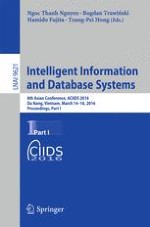The two-volume proceedings of the ACIIDS 2016 conference, LNAI 9621 + 9622, constitutes the refereed proceedings of the 8th Asian Conference on Intelligent Information and Database Systems, held in Da Nang, Vietnam, in March 2016. The total of 153 full papers accepted for publication in these proceedings was carefully reviewed and selected from 392 submissions.
They were organized in topical sections named: knowledge engineering and semantic Web; social networks and recommender systems; text processing and information retrieval; database systems and software engineering; intelligent information systems; decision support and control systems; machine learning and data mining; computer vision techniques; intelligent big data exploitation; cloud and network computing; multiple model approach to machine learning; advanced data mining techniques and applications; computational intelligence in data mining for complex problems; collective intelligence for service innovation, technology opportunity, e-learning, and fuzzy intelligent systems; analysis for image, video and motion data in life sciences; real world applications in engineering and technology; ontology-based software development; intelligent and context systems; modeling and optimization techniques in information systems, database systems and industrial systems; smart pattern processing for sports; and intelligent services for smart cities.
